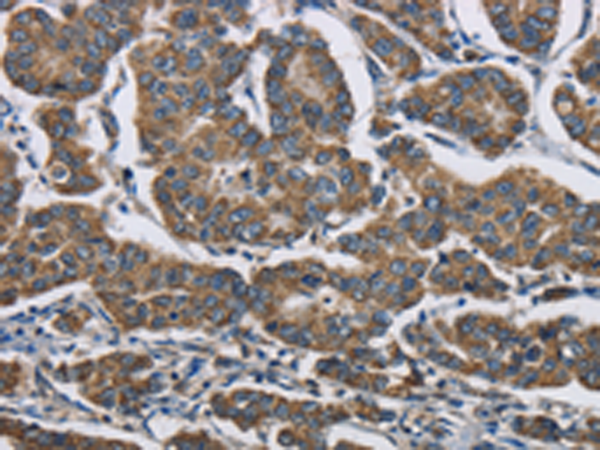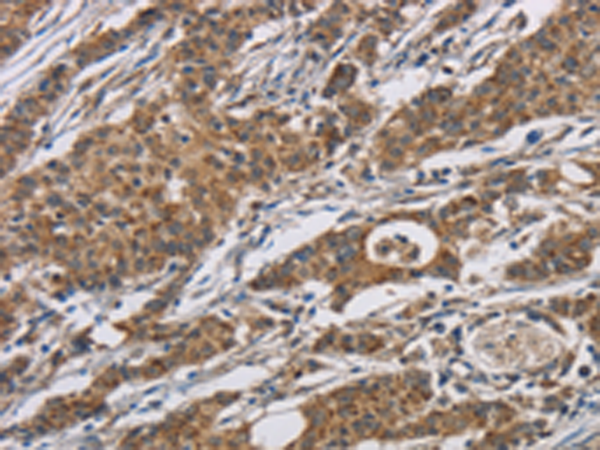


| WB | 咨询技术 | Human,Mouse,Rat |
| IF | 咨询技术 | Human,Mouse,Rat |
| IHC | 1/100-1/300 | Human,Mouse,Rat |
| ICC | 技术咨询 | Human,Mouse,Rat |
| FCM | 咨询技术 | Human,Mouse,Rat |
| Elisa | 1/2000-1/5000 | Human,Mouse,Rat |
| Aliases | RAGE |
| WB Predicted band size | 43 kDa |
| Host/Isotype | Rabbit IgG |
| Antibody Type | Primary antibody |
| Storage | Store at 4°C short term. Aliquot and store at -20°C long term. Avoid freeze/thaw cycles. |
| Species Reactivity | Human |
| Immunogen | Fusion protein of human AGER |
| Formulation | Purified antibody in PBS with 0.05% sodium azide and 50% glycerol. |
+ +
以下是关于AGER(RAGE)抗体的3篇参考文献及其摘要概括:
1. **文献名称**:*RAGE mediates a novel proinflammatory axis: the cell surface receptor for S100/calgranulin polypeptides*
**作者**:Hofmann, M.A., et al. (1999)
**摘要**:该研究首次提出RAGE作为S100/calgranulin蛋白的细胞表面受体,通过体外实验和抗体阻断实验,证实RAGE在介导炎症信号中的关键作用,为炎症性疾病机制提供了新见解。
2. **文献名称**:*Blockade of RAGE–amphoterin signalling suppresses tumour growth and metastases*
**作者**:Taguchi, A., et al. (2000)
**摘要**:文章利用RAGE抗体和小分子抑制剂,在肿瘤模型中证明阻断RAGE与配体amphoterin的相互作用可显著抑制肿瘤生长和转移,提示RAGE抗体在癌症治疗中的潜在应用。
3. **文献名称**:*Soluble RAGE therapy through recombinant sRAGE administration delays Alzheimer's disease progression in mice*
**作者**:Deane, R., et al. (2012)
**摘要**:研究通过向阿尔茨海默病模型小鼠注射可溶性RAGE(sRAGE)或抗RAGE抗体,发现其可减少β淀粉样蛋白沉积并改善认知功能,表明靶向RAGE的抗体策略在神经退行性疾病中的治疗潜力。
*注:以上文献为示例,实际引用时建议核对最新研究及数据库(如PubMed)以确保准确性。*
The receptor for advanced glycation end-products (RAGE), encoded by the AGER gene, is a multiligand transmembrane protein belonging to the immunoglobulin superfamily. Initially identified for its role in binding AGEs (harmful compounds formed during hyperglycemia), RAGE has since been implicated in diverse pathological processes, including chronic inflammation, diabetes complications, neurodegenerative diseases, and cancer progression. Its activation by ligands such as HMGB1. S100 proteins, and amyloid-β triggers pro-inflammatory signaling pathways (e.g., NF-κB and MAPK), driving oxidative stress and cellular dysfunction.
AGER antibodies, developed to target RAGE or its ligands, aim to disrupt these pathogenic interactions. Research highlights their therapeutic potential in diabetic complications (retinopathy, nephropathy), Alzheimer’s disease (reducing amyloid-β toxicity), and metastatic cancers (inhibiting RAGE-mediated invasion). Soluble RAGE (sRAGE), a natural decoy receptor, has inspired antibody designs to mimic its ligand-neutralizing function. Challenges remain in optimizing specificity, minimizing off-target effects, and ensuring efficient tissue delivery. Recent preclinical studies demonstrate promising outcomes, though clinical translation is ongoing. AGER antibodies represent a strategic approach to modulating RAGE’s dual role as both a sensor of damage-associated molecules and a driver of chronic diseases.
×